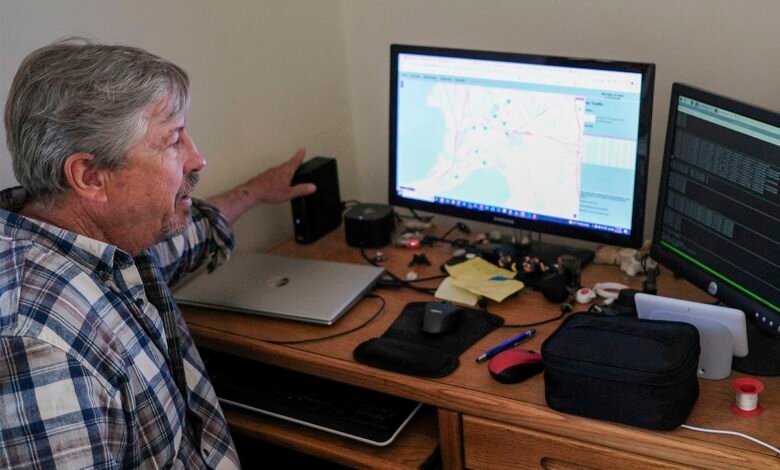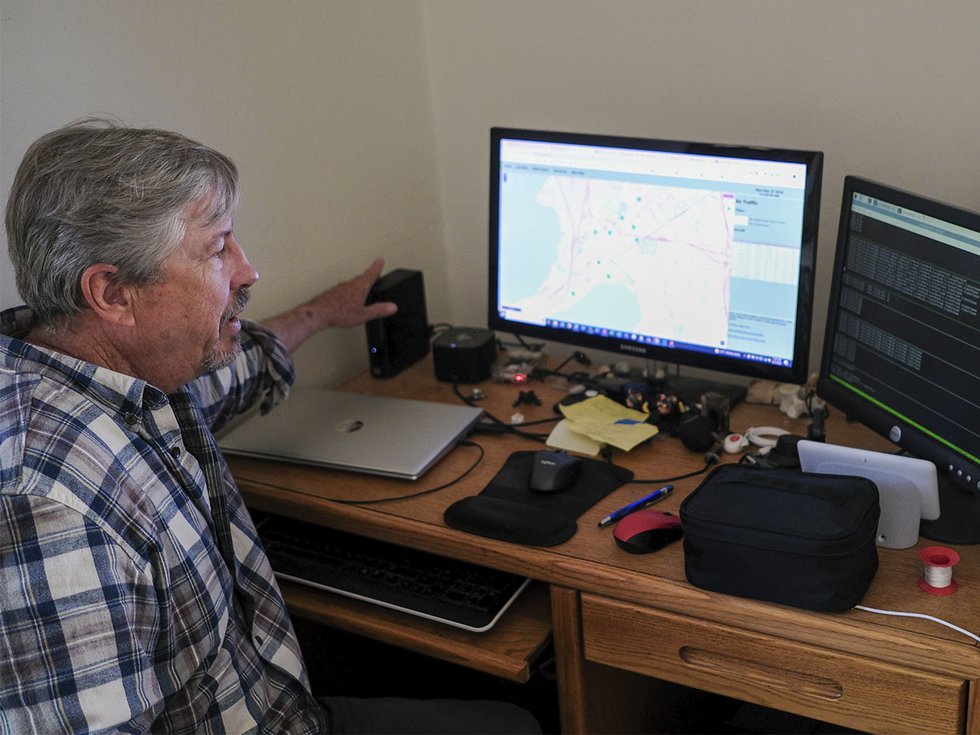Meet citizen scientist Scott Pigg – Isthmus


After partially retiring in 2023, Scott Pigg wasn’t sure what to do with his newfound time.
“I had loved my 30 years of collecting data and analyzing energy efficiency,” Pigg, a former energy analyst and resident on Madison’s east side, says during an interview at his home on a sunny morning in late May. “I didn’t want to give that up.”
A citywide aviation controversy would provide Pigg’s answer. Walking through his backyard, he points out an antenna he installed on his roof — “that’s tracking that jet that’s flying overhead right now,” he says, pointing at the sky — and the star of the show: a white plastic enclosure attached to a roughly four-foot tall stake, with a sound level meter on top that takes recordings every eighth of a second.
Pigg built the set-up himself and has now installed 17 others throughout the city. He hopes the data he has sourced from the monitors might provide clarity in Madison’s ongoing debates around noise exposure from F-35 fighter jets, though he does not take a position on whether the jets should be in Madison or not.
“Part of what I wanted to illuminate was how many minutes of noise do we get, how many noise events, how loud do they get,” Pigg says. “The stuff that regular people can get their heads around.”
Truax Field, located on the northeast side of Madison, has been a home base for F-35 fighter jets in the Wisconsin Air National Guard 115th Fighter Wing since April 2023. By 2027, they will leave 1,250 residential units in the surrounding area above the 65-decibel noise limit that the Federal Aviation Association says marks an area “incompatible” for residential land use, according to a Dane County Regional Airport noise study published in December 2022.
Many residents object to the high level of noise coming from the jets, pointing to racial and economic disparities, health concerns from noise level exposure, and environmental risks. In preliminary results of a statewide survey commissioned by the Madison F-35 Community Connection, a collection of government organizations involved with the F-35s, 84% of those submitting “very concerned/very negative” lived in the area zip code 53704 — the upper east side of Madison, which is most affected by the jet noise.
“Everything has to stop when they come over,” Jane, Pigg’s wife, says. “A friend lives closer to the airport. So if I’m talking on the phone with her, one will come by and we’ll have to stop talking.”
Pigg says he first got interested in the issue after hearing concern from some friends, who live close to the airport. He says they believed the new jets would be louder than the F-16s then based at Truax, and would be a “disaster.”
“I went to some public hearing and when the environmental impact statement came out, I read it and I actually ended up providing some comments on it. It was just kind of a lucky convergence.”
Pigg saw a need for more information on F-35 jet noise and a way to continue his love of data collection. He now hosts a website he launched in April 2022, msnsound.com, which provides live geographic updates of overhead noise.
Pigg says he had “two mantras” when he retired: “I want to do citizen science and make trouble with data. This thing spun up and then like, I was thinking about it one day, I just had this thought [that] maybe that would be a good project to do.”
His efforts are timely. City and county officials are currently at a standstill over whether to approve new housing near the airport, due to the high levels of noise.
But the jets aren’t going anywhere, officials say. During a June 6 community feedback session, David Buerle, a consultant hired by the Wisconsin Department of Military Affairs, noted that “you’ve got a group of people who are like ‘There’s only one option here,’ but that option is not on the table.”
Pigg attended the session. He says that he hopes his data can help military officials minimize the noise of their fighter jets: “Maybe the guard could use this and people can figure out a way to drop the decibel levels a little bit.”
Monitoring the noise exposure required that Pigg learn a suite of new skills and find resources. He already had experience in engineering and data monitoring because of his career as an energy analyst. But coding the algorithms necessary to pick out F-35 noise, building a website with live updates to display the data he collects and uploading the satellite’s aviation traffic data led Pigg down a rabbit hole of manuals and textbooks.
“I had to learn how to code everything, I had to write some software on my end, read it all in and put it into a database — it’s been a great learning experience for me.” Pigg says.
He began monitoring the fighter jet noise in 2021, when it was coming from F-16s. Pigg says each noise monitor costs around $100. They take decibel readings — the unit used to measure the intensity of a sound — every eighth of a second, and once every second, they send the data back to a computer in an office at Pigg’s house. From there, the data is automatically updated on the website and entered into Pigg’s records.
By algorithmically sorting out non-fighter jet noise, using flight data and selecting F-35 noise events (specific date and time-stamped “aircraft-related increases in decibel levels) — which Pigg does by hand — Pigg gets a granular view of the peak sound levels coming during any period of time. Pigg says the fighter jets are “unmistakable” in their extreme sound intensity.
“When they take off to the south, they’ll light up like eight meters over 100 decibels. It’s just like nothing else. The tornado sirens aren’t nearly as loud,” Pigg says.
Location can make a sizable difference in decibels: Madison’s east side is more affected by incoming jet landings, Pigg says, when the jets loop over the Atwood neighborhood before landing on the runway, and the more sparsely populated north side experiences greater noise exposure during take-off. The 115th Fighter Wing has modified its flight patterns to reduce residential noise exposure, but many residents say the same booming low frequency noise still affects their day-to-day lives.
“We will request the north takeoff, hold and wait, and then take off to the north,” Col. Ben Gerds with the 115th Fighter Wing told audience members at the June 6 listening session. “The only time they won’t do that is if it’s going to be a significant delay — 20-30 minutes — or it would be a safety of flight type issue for the pilot because the runway is wet or the wind just wouldn’t support it.”
Pigg has been supported in his work by volunteers willing to let him put the noise monitors in their yards — “mostly people who were very opposed and worried about the F-35s,” he says — and $500 grants each from the Schenk-Atwood-Starkweather-Yahara Neighborhood Association and the environmental and antiwar advocacy group Safe Skies, Clean Water, both of which oppose the F-35s being stationed at Truax.
Vicki Berenson, a spokesperson for Safe Skies, Clean Water Wisconsin, tells Isthmus that she is appreciative of Pigg’s work.
“What Scott’s doing is really important,” Berenson says. “Because he’s measuring peak levels, whereas the airport and the Air Force and the guard are using daily average noise levels to decide what’s safe and what isn’t safe.”
Pigg hopes his data can provide greater context and dispel anecdotes in Madison’s F-35 debate. The peak noise he measures is different from the day-night average sound level Berenson mentioned, which calculates the cumulative noise exposure a citizen in a geographic area receives in a 24-hour period. It’s the metric by which the FAA measures sound exposure — anything above 65 decibels is considered incompatible with residential use — but residents say that the peak noise levels are of greater concern.
Mark Allie, an electrical engineering and acoustics professor at UW-Madison, says the daily average noise metric doesn’t take into account “annoyance” from intermittent high noise events, a problem that Pigg can monitor with his peak noise levels. The legal regulations around noise insulation and noise exposure rely on the average noise metric, Allie says, because it’s simpler to measure and the health effects of average noise are well-studied.
Still, Allie says it’s easier “to make a bad situation look good with averaging.” Though daily average noise is used to gauge health-based ramifications of noise exposure, it does not take into account the irritation people might receive from the F-35s.
“It’s a big question — Are you worrying about people being annoyed or not?,” Allie says. “It’s well defined in some ways, but not very well defined in laws and restrictions and rules and regulations.”
Pigg sees a need for more detailed data. He hopes to have regulators, policymakers and developers use his data to figure out a path forward, particularly as it relates to reducing noise from the guard and seeing how developers might still build near the airport.
Allie says Pigg’s data looks solid and looks like he was “doing things correctly and making measurements correctly.” He says that the relatively low cost of Pigg’s equipment should not reflect poorly on his findings: “You have to have a really crappy piece of equipment not to get decent data.”
“The fact that it’s so cheap suggests that it isn’t necessarily made out of high, really expensive stuff, but that doesn’t mean that it can’t do a good job,” Allie adds. Pigg’s data would be useful and valuable to anyone studying the acoustic effect of the F-35s, Allie says. The only problem Allie foresees is whether those in charge of decisions around the F-35s take it seriously.
“They would have to admit that ‘Yes, this $50 meter can do the job. Here’s the data, we’ll accept it,’” Allie says. “Or they can just say no, it’s not the $5,000 B&K meter. So forget it, and go away. It depends on who you’re talking to and what kind of point they’re trying to make or or escape from making or or being held responsible.”
Pigg plans to continue with noise monitoring, both for the F-35s and for other ventures. “There’s stuff where you can put out microphones and track birds by their calls, and bats and stuff,” he says. “Oh man, I’m ready to go to town on some of the more natural history.”
His efforts so far have connected him with a greater scientific and activist community around airport noise. He has made contact with people in Burlington, Vermont — “our sister city in fighter jet hell,” Pigg says, referencing the city’s hosting of F-35s for the Vermont Air National Guard — Denver, Colorado, and the National Noise Pollution Clearing House, which he says “was interested in some of my data for looking at new metrics.”
For Pigg, having neutral data available is the minimum needed for anyone to find common ground.
“For aircraft noise, the only way the airports tracked it for years and years was the number of complaints that they got,” Pigg says. “You had all this chatter back and forth about the fighter jets, ‘They’re so awful’ and ‘They’re just a few seconds a day’ or whatever, right. I really just wanted to provide some neutral information — here’s what it is.”


